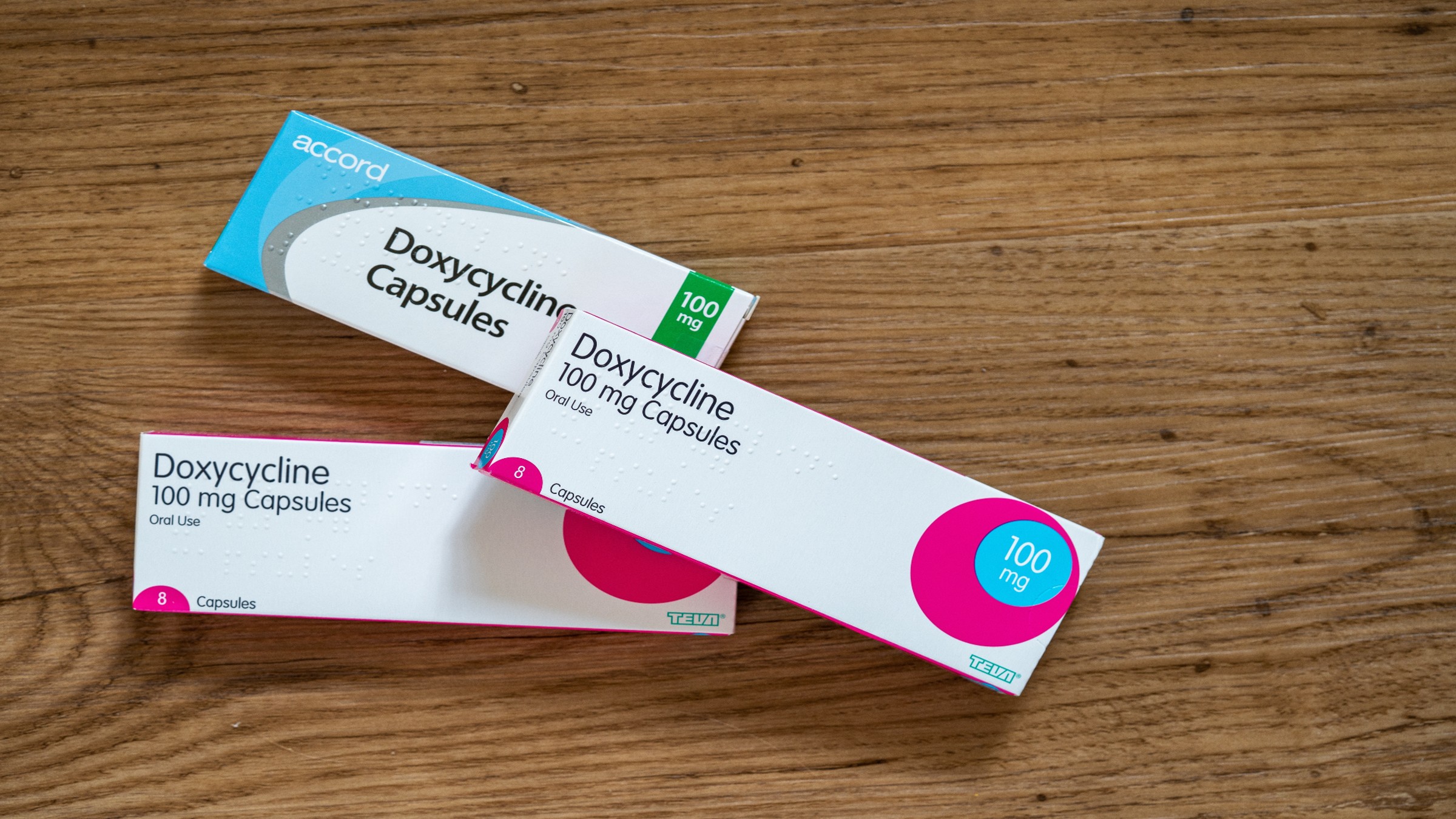Could an antibiotic taken after unprotected sex prevent STIs? What to know about doxy-PEP.
This summer, the CDC is expected to release guidelines for the use of doxy-PEP to prevent STIs. But what is it, and why is everyone talking about it now?

The U.S. is currently facing a surge in sexually transmitted infections (STIs). To address that rise, doctors have raised the possibility of prescribing some people an antibiotic to take after risky sexual encounters to prevent such infections.
The drug regimen, known as doxy-PEP, uses an old antibiotic called doxycycline and may reduce the risk of developing three major STIs — syphilis, gonorrhea and chlamydia — in people who are at high risk of repeated infection, evidence suggests. The Centers for Disease Control and Prevention (CDC) is currently evaluating these data and is expected to announce new guidance this summer. If that goes through, the FDA may expand the list of ways the doxycycline should be prescribed to include post-exposure prophylaxis (PEP) in certain populations.
Here's what we know so far about doxy-PEP, including who it might work for and whether it could fuel antibiotic resistance.
What is doxy-PEP, and how does it work?
Doxy-PEP gets its name from both its main active ingredient, the antibiotic doxycycline, and the type of therapy, post-exposure prophylaxis (PEP).
Doxycycline belongs to a group of antibiotics known as tetracyclines, which inhibit the growth of bacteria by stopping them from making essential proteins. Doxycycline is a mainstay in treating bacterial infections such as acne, urinary tract infections, eye infections and STIs. Normally taken as a tablet once or twice a day, doxycycline can start to improve a patient's symptoms within two days.
PEP, meanwhile, is best known for use in human immunodeficiency virus (HIV). PEP involves taking a drug as soon as possible after a potential exposure to a pathogen to prevent infection.
In the case of doxy-PEP, this would mean taking doxycycline within three days of having sex without a condom to stop the development of certain STIs. This would prevent bacterial growth before symptoms emerge, as opposed to treating the symptoms afterward.
Sign up for the Live Science daily newsletter now
Get the world’s most fascinating discoveries delivered straight to your inbox.

How effective is doxy-PEP?
So far, most research into doxy-PEP has been in men who have sex with men (MSM) and transgender women and has focused on preventing the spread of gonorrhea, chlamydia and syphilis.
A 2018 study in France, for example, found that taking a single 200-milligram dose of doxy-PEP within 24 hours after having condomless sex could reduce the risk of chlamydia and syphilis by around 70% in MSM. Another study looked at gay and bisexual men, transgender women and nonbinary people assigned male at birth who'd already been diagnosed with an STI. When they were prescribed doxy-PEP for one year after having an STI diagnosis, future infections dropped by more than 40%.
In April, a study published in The New England Journal of Medicine (NEJM) also found that treatment with one 200-mg pill of doxycycline within 72 hours after condomless sex lowered the risk of new STI infections by two-thirds compared with standard care in a trial of over 500 MSM and transgender women.
But the drug is still far from being a one-size-fits-all solution.
"Our study does not inform everybody," Dr. Annie Luetkemeyer, lead author of the NEJM paper and a professor of medicine and infectious diseases at the University of California, San Francisco, told NPR. "It informs a group of people who already had an elevated risk of sexually transmitted infections."
Moreover, in cisgender women, a small study did not find a lower rate of STIs with doxy-PEP, although trials are ongoing. Because antibiotics only work against bacteria, doxy-PEP also cannot treat HIV or other infections caused by viruses, such as herpes or mpox.

What are the side effects of doxy-PEP?
According to the CDC, potential side effects of doxycycline include phototoxicity, meaning greater sensitivity to sunlight, gastrointestinal symptoms and, in rare cases, the development of ulcers in the esophagus. Other possible complications include a loss of appetite, nausea and diarrhea.
Has doxy-PEP been approved, and if so, who should take it?
Doxy-PEP is still currently classified as "off-label" by the Food and Drug Administration, meaning preventive treatment for bacterial STIs is not one of the listed uses on its approval label. (Doctors can and frequently do prescribe medicines off-label for all sorts of reasons.)
However, the CDC is currently considering the mounting evidence, including the positive results of the most recent NEJM trial this year, and is expected to announce clinical guidance for doctors and health care providers this summer. The FDA usually follows the guidance of the CDC on such matters.
"The evidence is very strong," Dr. Leandro Mena, director of the CDC's division of STD [sexually transmitted disease] prevention, told NPR. The new guidance will likely focus on groups that are at a higher risk of repeatedly contracting STIs — namely, MSM and transgender women.
In the meantime, the CDC acknowledges that some people are already using doxy-PEP and, in response, has issued protective interim guidance. This includes being aware of the target populations studied in recent trials, the dosage and the fact that other antibiotics should not be considered for PEP. (If someone shows symptoms of an STI and has had a recent exposure, they should get evaluated by a doctor.)
Could doxy-PEP worsen antibiotic resistance?
One risk of using doxy-PEP is that it may worsen the "urgent public health threat" of antibiotic resistance, in which bacteria evolve such that antibiotics work less effectively or no longer work at all against the germs.
Infectious-disease doctors are particularly worried about Staphylococcus aureus bacteria, which normally live harmlessly in the nose and skin but can cause deadly infections if they get into the blood, NPR reported. Indeed, in the NEJM trial, the prevalence of doxycycline-resistant S. aureus increased by 8% among people taking doxy-PEP.
Similarly, Neisseria gonorrhoeae, the species of bacteria that causes gonorrhea, can quickly develop resistance to tetracyclines, the class of antibiotics that includes doxycycline. In fact, 25% of cases of gonorrhea in the U.S. are already caused by tetracycline-resistant bacteria.
However, Luetkemeyer pointed out that people who get frequent STIs will also have to use antibiotics to clear them up.
"This isn't a choice between antibiotics and no antibiotics in men and transgender women with a history of recurrent STIs," she said in a statement. "The alternative here for many is repeated STIs that lead to recurrent antibiotics."
Others are similarly optimistic. Dr. Jeffrey Klausner, a professor of clinical population and public health sciences at the University of Southern California, told Live Science in an email that doxycycline is a "breakthrough in sexual health" and offers a "new choice for sexually active adults to protect themselves from STIs" such as syphilis, chlamydia and gonorrhea.
This article is for informational purposes only and is not meant to offer medical advice

Emily is a health news writer based in London, United Kingdom. She holds a bachelor's degree in biology from Durham University and a master's degree in clinical and therapeutic neuroscience from Oxford University. She has worked in science communication, medical writing and as a local news reporter while undertaking NCTJ journalism training with News Associates. In 2018, she was named one of MHP Communications' 30 journalists to watch under 30. (emily.cooke@futurenet.com)
What are mRNA vaccines, and how do they work?
Deadly motor-neuron disease treated in the womb in world 1st










